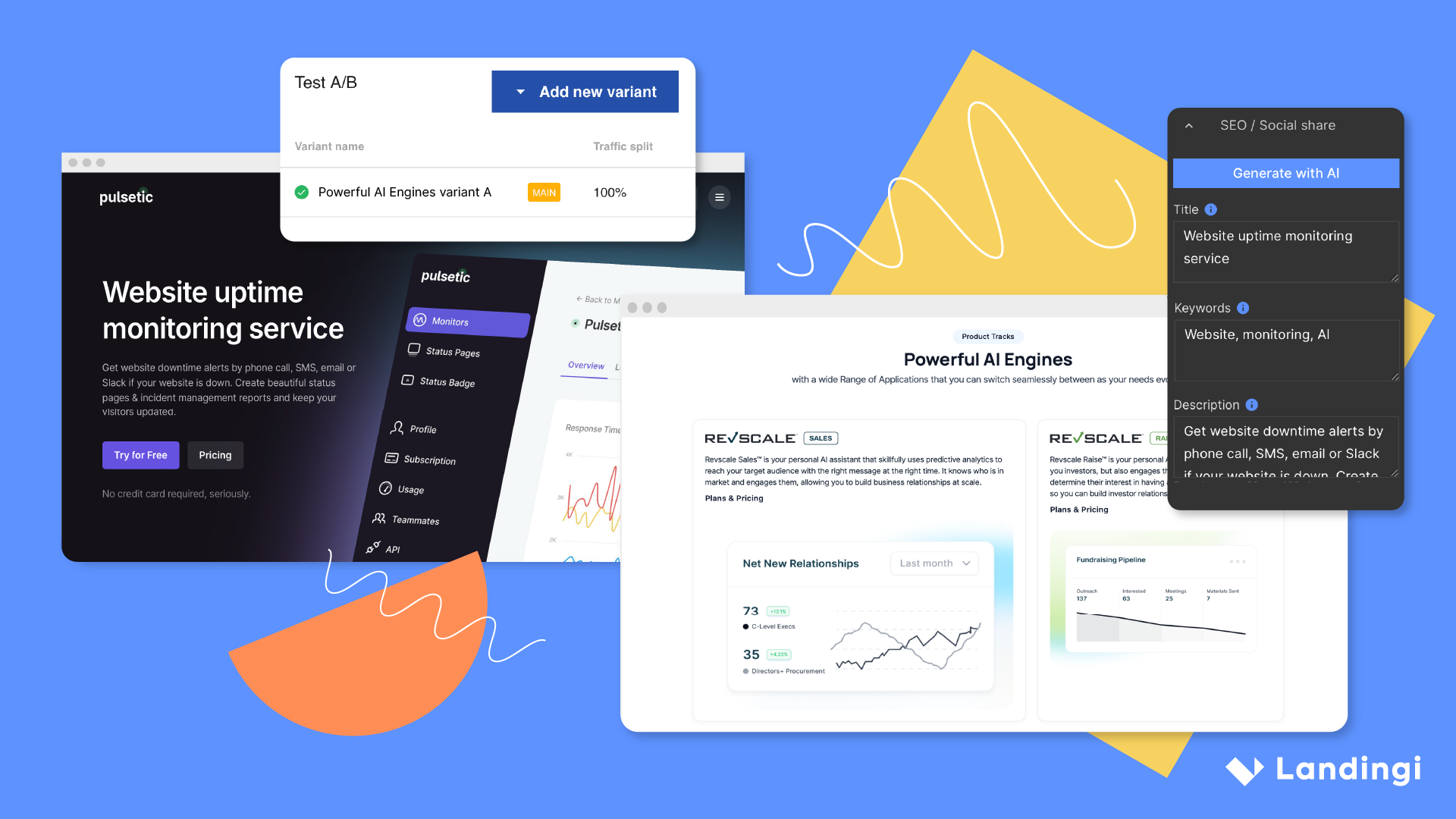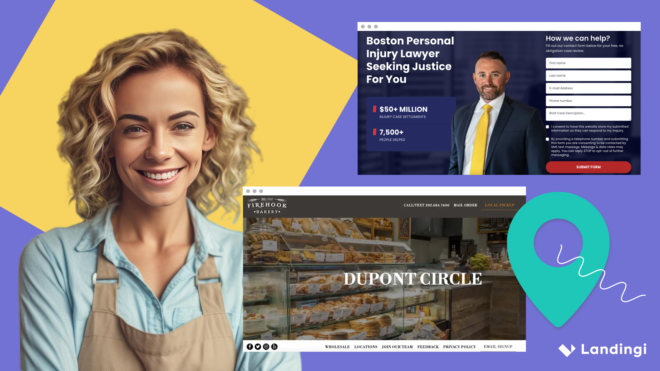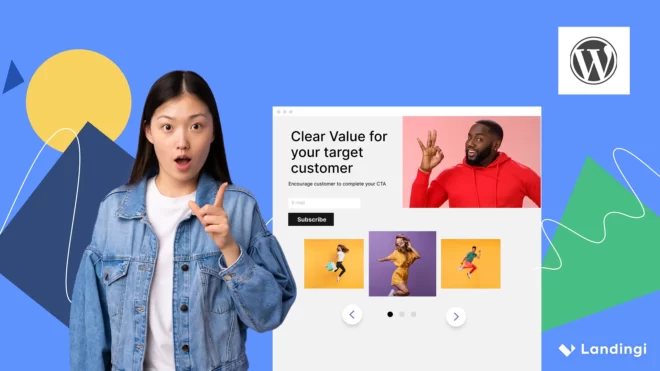Did you know, that 77% of landing pages are actually used as the primary home pages? Especially in Software and SaaS industries, landing pages effectively promote products and encourage users to give them a try.
A software landing page is a weapon in your marketing strategy – in this article, we explain the purpose of software landing pages and go through the best examples to share essential knowledge on how to create a high-converting one.
Before you meet landing page examples, take a look at the following pro tips:
- Understand your audience
- Set a singular goal
- Explain your product
- Focus on user experience
- Unleash creativity
- Create an irresistible offer
If you wonder how to implement the advice in reality, check out our best software landing page picks and learn what is important while creating your own page from detailed examinations.
Software Landing Page Examples:
Make your sections smartable and let go of mundane manual tasks with Smart Sections! An easy way to manage bulk changes.
What Is a Software Landing Page?
A software landing page is a standalone webpage specifically designed for a particular software product or service. Its primary goal is to inform about innovative solutions and attract visitors enough to convert them into leads or customers.
Software landing pages focus solely on driving conversions with a single call to action. These landing pages are often the entry point for visitors arriving from marketing campaigns like pay-per-click advertising, social media, or email campaigns.
Landing pages created for a specific software often aim the warm sales funnel, providing informative content that awakens a sense of need in potential customers. The software landing page focuses on a unique value proposition, pointing out all the benefits of using the showcased solution. CTAs often lead to a free trial or demo request, which can be a point of marketing strategy targeted on a hot sales funnel.
The effectiveness of a software landing page lies in its focused message that aligns with the visitor’s expectations and encourages them to complete the desired action without distractions. They are crafted with the intention of optimizing the return on investment (ROI) for marketing efforts by focusing on lead generation or conversion actions.
Software landing pages are the middle point of marketing strategies for businesses such as Software Houses or SaaS companies. They serve as strategic tools, opening the way to scaling businesses. In this case, landing pages are also the best option to gather valuable insights – not only about the target audience and user behavior but also their needs, expectations, and evaluations that lead to optimization of both the site and the product itself.
How Do I Create a Software Landing Page?
To create a landing page for your software, choose the right tool, like Landingi – a multifunctional platform for crafting and optimizing landing pages with minimal effort, and follow the 9-step guide to ensure it effectively showcases your software and drives conversions:
1. Define your target audience and goals
Start by understanding who your software is for and what problem it solves for them. This will help you tailor the content and design of your landing page to speak directly to your audience’s needs and motivations. Set clear goals for your landing page. It can be generating leads, driving software downloads, or encouraging sign-ups for a free trial.
2. Choose the right landing page builder
Select a landing page builder that offers the flexibility and features you need. Look for platforms like Landingi, which offer customizable templates and user-friendly interfaces. Ensure the builder you choose supports integrations with other tools you use, like email marketing services or CRM systems.
3. Create catchy headlines
Your headline should instantly convey the core benefit of your software. It should be attention-grabbing and clearly state what your software does. The subheadline should provide additional details, elaborate on the headline, and further explain the software’s benefits.
Pro Tip: Use adequate style and tone of voice – this should align with your product approach. To simplify the process, use AI Assistance to get stunning headlines that cut through the noise and boost the user’s attention.
80% of visitors will read the headline, but only 20% will read the rest, according to Copyblogger statistics. There’s room to boost those numbers: create a headline that will be memorable for a long time and provoke people to seek more information.
4. Highlight key features and benefits
Use bullet points or short paragraphs to outline your software’s key features and benefits. Focus on how your software solves specific problems or improves the user’s life or work. Avoid technical jargon and focus on user-friendly language. Ensure you matched the messaging to the target audience’s expectations.
5. Use high-quality visuals
Include screenshots, videos, or graphics that showcase your software in action. Visuals can help visitors quickly grasp what your software looks like and how it works. A video demo or animated explainer can be particularly effective.
According to Wyzowl’s latest statistics, 69% of consumers feel that a product demo is the most helpful tool when deciding on a purchase, and 75% of individuals view short-form video content on their mobile devices, as presented in Inside Intelligence’s statistics – if you aim high conversion, short video on your software landing page is a must.
6. Include social proof
Add testimonials, case studies, or user reviews to build credibility and trust. Social proof helps reassure visitors that others have successfully used and benefited from your software. Such practice not only boosts conversions but also impacts your brand’s big picture.
7. Create a strong CTA
Your CTA should stand out and encourage visitors to take the next step, whether it’s signing up for a free trial, scheduling a demo, or downloading your software. Make sure it’s visible, compelling, and straightforward.
8. Optimize for Search Engines (SEO)
Use relevant keywords in your content to improve your landing page’s visibility in search engine results. This includes incorporating keywords in headlines, subheadlines, and body text that your target audience will likely use when searching for software like yours.
At this stage, Landingi provides AI Assistance + SEO feature, which allows you to set the right keywords effortlessly in seconds.
9. Test and Optimize
Continuously test different landing page elements (like headlines, CTAs, and images) using A/B testing tools. At this point, analytics tools to track visitor behavior and conversions are essential. Instead of looking for external tools, you can use EventTracker to gather important insights right in your Landingi dashboard. This feature allows you to make data-driven decisions to optimize your landing page’s performance.
Once your software landing page is published, the journey of achieving conversions starts – drive traffic to the page through channels such as PPC, social ads, and email marketing to maximize reach.
8 Best Examples of Software Landing Pages
Now that you understand the purpose of a software landing page and have gathered essential knowledge on its creation process, let’s explore 8 great examples. Our picks showcase various approaches and strategies that effectively drive conversions to sell software products.
Each landing page offers unique insights into how a well-crafted software landing page can look and function. In addition, you can find the best software landing page templates that can be a great starting point for creating your unique pages.
1. Revscale
Revscale’s SaaS landing page effectively showcases an AI-driven revenue optimization platform. It features a clean design, a great value proposition, and a strong call-to-action, making it easy for visitors to understand the value they offer. The landing page emphasizes the ability to use their products quickly, with a setup time advertised as little as a day, highlighting efficiency and speed.

This landing page design relies on clarity – the layout is highly intuitive, with strategic white space and clear CTAs. What makes a big difference is including interactive, animated sections that flow while scrolling through the page. Implementing trust elements like customers’ brand names and integrations encourages visitors to take action. The single opt-in form for demo requests is outstanding and clear with its straightforward messaging, which increases conversions.
Key takeaways to learn from this example:
- Clear, intuitive layout,
- Outstanding CTA buttons,
- Interactive elements,
- Concise, informative content,
- Benefits section,
- Trust elements,
- Simple form.
Improvement areas:
- Lack of user testimonials – real-life use cases with user reviews would increase credibility, leading to higher conversion rates.
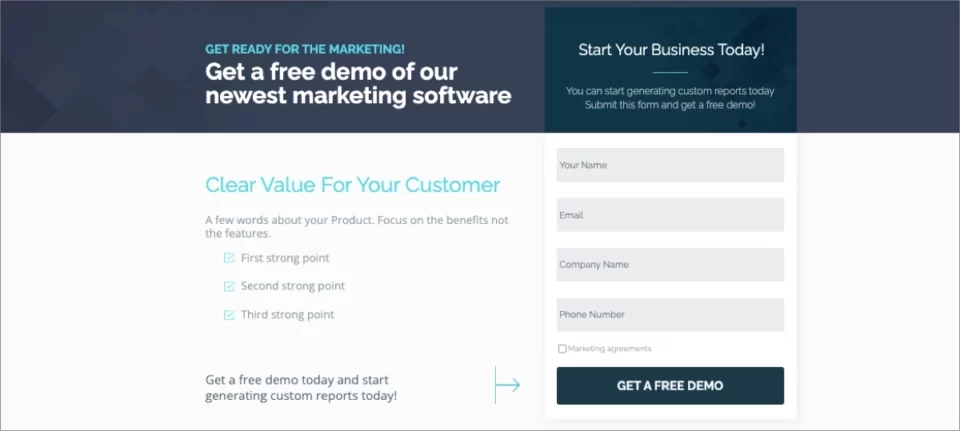
Pick the best software landing page template from Landingi’s template gallery and customize it easily within the drag-and-drop editor to achieve similar results.
2. Pulsetic
Pulsetic’s software landing page stands out with its visually appealing design, engaging animations, and persuasive testimonials. The landing page promotes the ability to monitor websites from data centers around the world, ensuring redundancy and localizing outages. Pulsetic’s landing page contrasts its pricing with other services, highlighting its affordability, and offers a free account option.

Their landing page design is clear and based on a white background, which affects its intuitiveness. An outstanding CTA catches attention with its color and messaging, encouraging to try the tool for free. They boost credibility by implementing a social proof section with user testimonials and presenting badges with ratings from important industry platforms.
Key takeaways to learn from this example:
- Intuitive layout,
- Strong CTA buttons,
- Informative feature descriptions,
- Comparison table,
- Pricing,
- Social proof section,
- Attractive, outstanding live-chat icon.
Improvement areas:
- Interactive elements – the page could include more interactive elements, videos, or animations to boost user engagement.
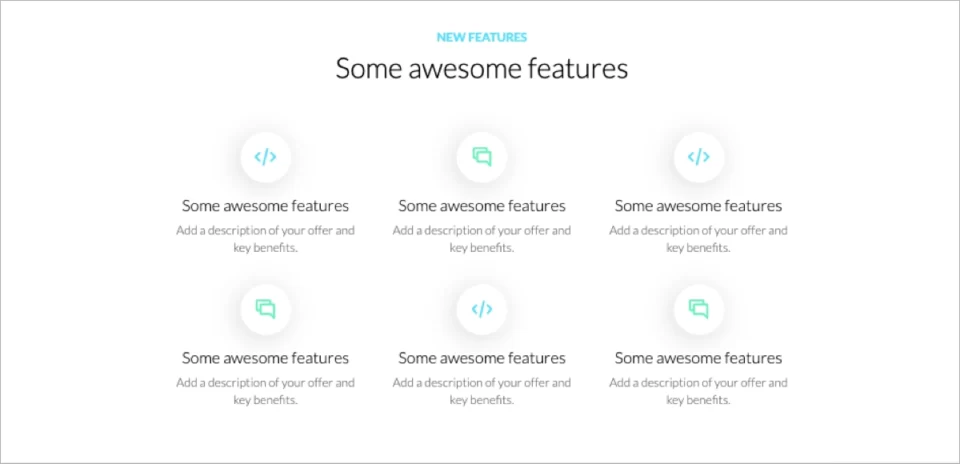
Showcase your product effectively with the perfect software landing page templates – choose the best landing page builder, pick one from over 400 available templates, and customize it with a user-friendly builder. Once it’s published, you can optimize the page for higher conversion rates with built-in features, all in one practical dashboard.
3. Todoist
Todoist’s software landing page effectively emphasizes the benefits of their task management app through a simple layout, clear messaging, and social proof. The landing page showcases Todoist’s different organizational views, such as list, calendar, and board, to appeal to various user preferences and workflows. A focus on user reviews is evident with the mention of 330,000+ five-star reviews on Google Play and the App Store, reinforcing the app’s credibility and popularity.

The landing page presents Todoist as a tool that can handle a wide range of projects, from personal shopping lists to million-dollar IT projects, showcasing its scalability. Still, the landing page design is simple and kept in clear convention – it not only simplifies navigation, but refers to their product’s functionality. They implemented interactive elements and animations that showcase basic and advanced features.
Key takeaways to learn from this example:
- Easy to navigate layout,
- Outstanding, straightforward CTAs,
- Visually appealing interactive elements,
- Social proof section and trust elements,
- Informative but concise content.
Improvement areas:
- Customer testimonials – as their customers are also renowned brands, they could implement testimonials and reviews to boost visitors’ trust and engagement.
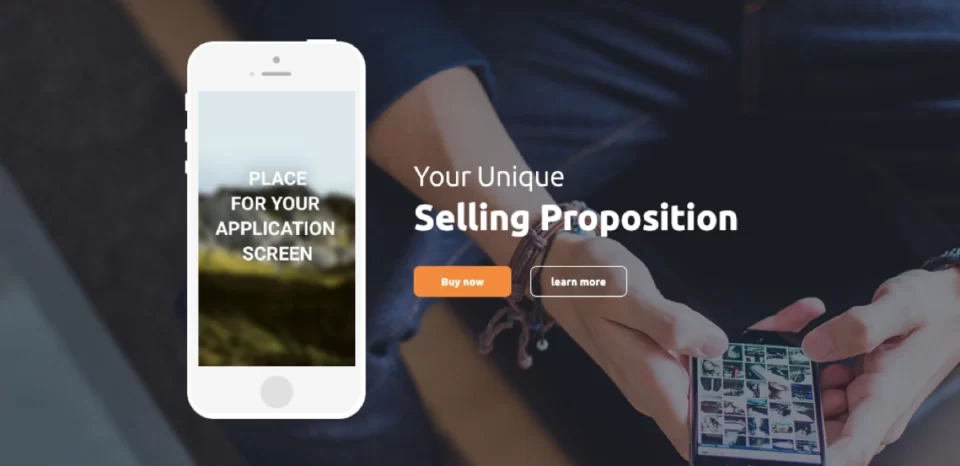
Try Landingi for free and create your software landing page effortlessly – start by choosing the best template, which can be easily customized with a user-friendly editor.
4. Directus
Directus’s landing page showcases their open-source data platform with a bold design, interactive elements, and a comprehensive feature list. The landing page features a guide on creating custom landing page modules within the Directus ecosystem, providing a flexible platform for developers to build tailored solutions.

The landing page includes informative descriptions, a benefits section, and case studies that tell real-life usage stories, enhancing user interest. Animated product demo is a trigger for visitors who know their needs, showcasing ease of use and encouraging them to sign up for free access.
Key takeaways to learn from this example:
- Simple page design,
- Outstanding CTAs with straightforward messaging,
- Animated demo,
- Case studies section,
- Concise, well-written content.
Improvement areas:
- Mobile responsiveness – the page could be optimized for better loading speed to avoid high bounce rates.

Choose the Buy Software template and create an irresistible offer, set outstanding CTAs, and implement a high-converting form to measure your success, all in one multifunctional platform for creating, testing, and optimizing landing pages – Landingi.
5. Folderly
Folderly’s software landing page is a great example of using a minimalist design to highlight the product’s key features and benefits. The page effectively promotes an email deliverability platform with a clean design, compelling copy, and strong social proof. The landing page’s copy is persuasive and focuses on solving the customer’s problem – improving email deliverability.
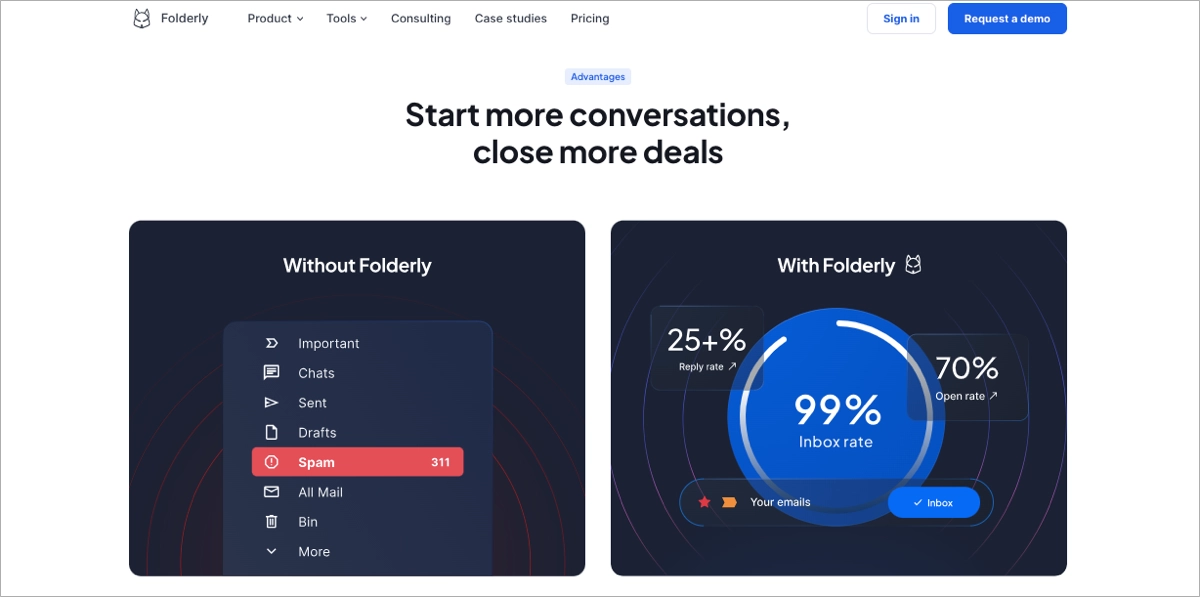
The landing page also showcases social proof in the form of customer testimonials. These testimonials build trust with prospective customers by providing real-world examples of the benefits that Folderly’s customers have experienced. The call-to-action on the landing page is clear and compelling, encouraging visitors to start a free trial.
Key takeaways to learn from this example:
- Clear layout with outstanding CTAs,
- High-quality visuals and animated elements,
- Concise descriptions,
- User reviews and award badges,
- Data-based user results,
- Comparison table,
- FAQ section.
Improvement areas:
- Extensive demo request form – it should be as short as possible, involving only necessary form fields, to drive higher conversions.

Choose the Technology landing page template to create your own software landing page that converts. You can easily customize it within a user-friendly editor and effortlessly change your ideas into reality.
6. Gamma
Gamma’s software landing page highlights their no-code app builder with an engaging design, interactive demo, and clear value proposition. The landing page’s design is clean yet colorful and modern, focusing on the product’s key features and benefits. The copy on the landing page is persuasive and focuses on how Gamma’s no-code app builder can help businesses build apps quickly and easily.

The landing page also includes an interactive demo allowing visitors to see their product. This demo gives potential customers a clear idea of what they can achieve with the product, increasing the likelihood of conversion. The landing page also includes eye-catching calls to action, encouraging visitors to start a free trial of their product.
Key takeaways to learn from this example:
- Stunning design with intuitive layout,
- Interactive, animated elements,
- Effective headlines,
- Informative content,
- Visually appealing graphics and videos,
- User testimonials.
Improvement areas:
- Loading speed – the page should load faster to ensure a seamless user experience and prevent increasing bounce rates.
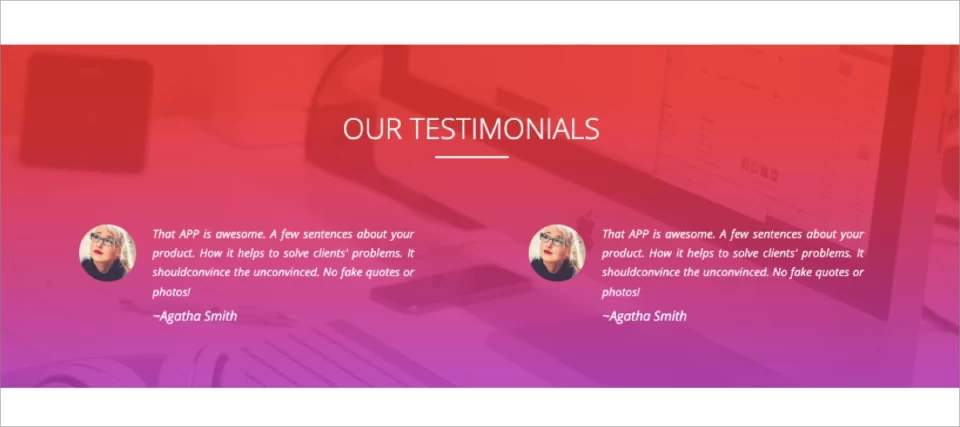
Remember to implement the user testimonials and reviews section while customizing your template. It’s easy with Landingi’s drag-and-drop editor.
7. Raycast Pro
Raycast Pro’s landing page showcases their productivity tool with a minimalist but stunning design, persuasive copy, and great CTA. The landing page’s design is simple and uncluttered, making it easy for visitors to focus on the product’s key features and benefits. The copy on the landing page is compelling and focuses on how Raycast Pro can help individuals and teams improve their productivity.
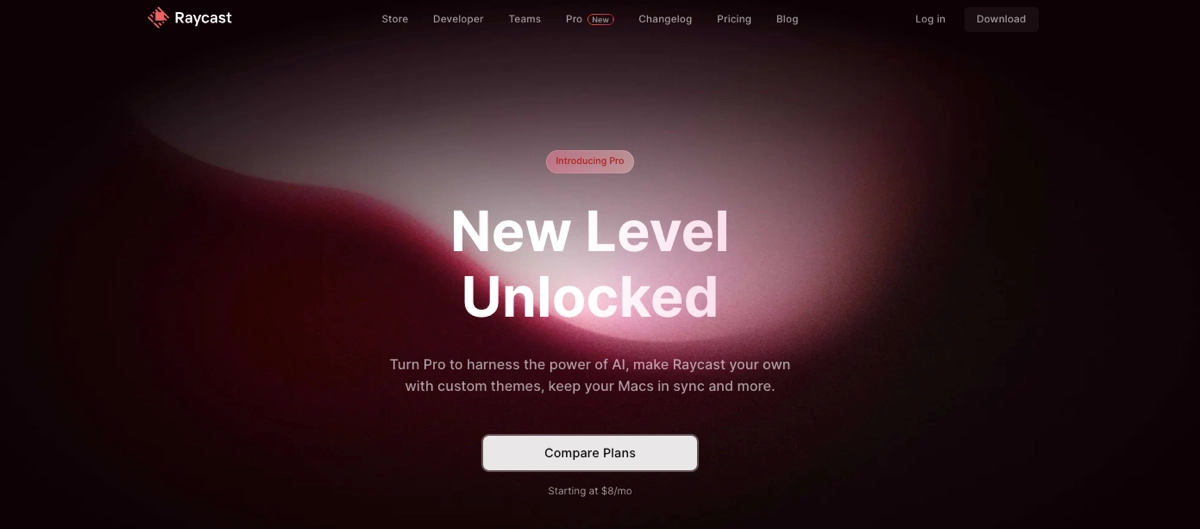
The landing page includes a strong call-to-action with clear price information that encourages visitors to download the productivity tool. Feature descriptions are better thanks to their concise form and high-quality visualizations. Interactive, animated elements boost user engagement, and the FAQ section provides additional information, ensuring visitors know about the product’s value.
Key takeaways to learn from this example:
- Minimalist design, clear layout,
- Strong CTAs with price information,
- Effective headlines and concise feature descriptions,
- High-quality, engaging visuals,
- FAQ section,
- Full pricing information.
Improvement areas:
- User testimonials – including user testimonials would increase trust among visitors, leading to higher conversions.
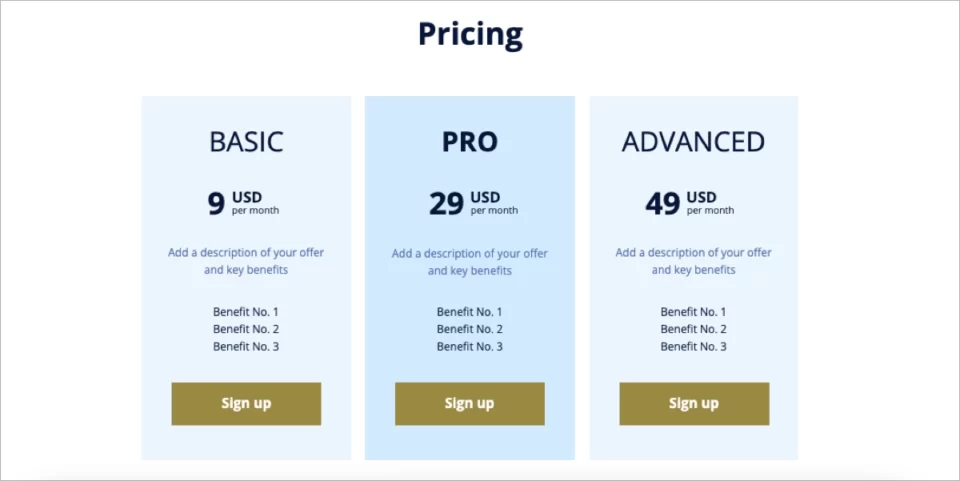
Pick the template that involves a pricing section to streamline the landing page creation process, or use Landingi’s builder to implement a section that informs about the product plans available.
8. VSCO
VSCO’s landing page promotes their photo editing app with a visually appealing design, user-generated content, and clear messaging. The landing page’s design is beautiful and modern, focusing on showcasing their product capabilities. What sets the page apart from other software landing pages is horizontal navigation, but this high-end design consists of an eye-catching, visually appealing mix of graphics and headlines supplemented with encouraging CTAs.

The copy on the landing page is persuasive and focuses on how VSCO can help users create stunning photos. The landing page also includes user-generated content in the form of photos that have been edited using the app. This content gives potential users a clear idea of what they can achieve with the app, increasing the likelihood of conversion – written testimonials are unnecessary in this case.
Key takeaways to learn from this example:
- Stunning yet clear layout,
- Encouraging CTAs,
- Eye-catching, visually appealing graphics,
- User-generated content,
- Horizontal navigation,
Improvement areas:
- Shorter signup form – the form includes unnecessary fields and asks for personal data like date of birth. Eliminating this field would positively impact the conversion rate.
4 Software Landing Page Best Practices
Meet the 4 software landing page best practices to help you build a high-converting, visually appealing, and user-friendly landing page for your product.
1. Setting a singular goal
First essential practice involves centering on a singular goal. Creating an effective software landing page goes beyond just crafting an aesthetically appealing page; it demands a strategic approach. Whether it’s getting users to sign up for a free trial or make a purchase, your landing page should be designed to guide visitors toward that specific action.
Take a look at the example below:
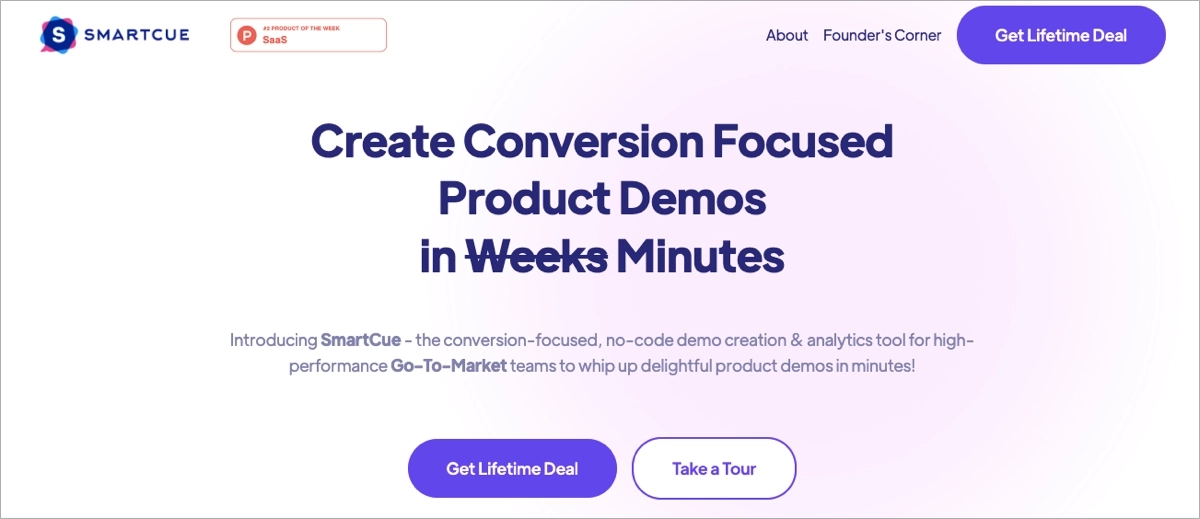
The main CTA button is repeated in strategic sections of the landing page. Its design is outstanding, and the messaging is straightforward yet engaging – a properly designed button should be used several times on the page. You shouldn’t use various buttons, as it distracts users from the main purpose and makes achieving a singular goal harder.
2. Using a simple form
The second best practice is to implement a short, simple form. Avoid using extensive forms and never ask for personal, sensitive data. Asking for a date of birth or address can decrease conversions by up to 4%, according to Feathery research. The form should be clear, easy to fill, and supplemented with an encouraging CTA button.
Take a look at the example below:
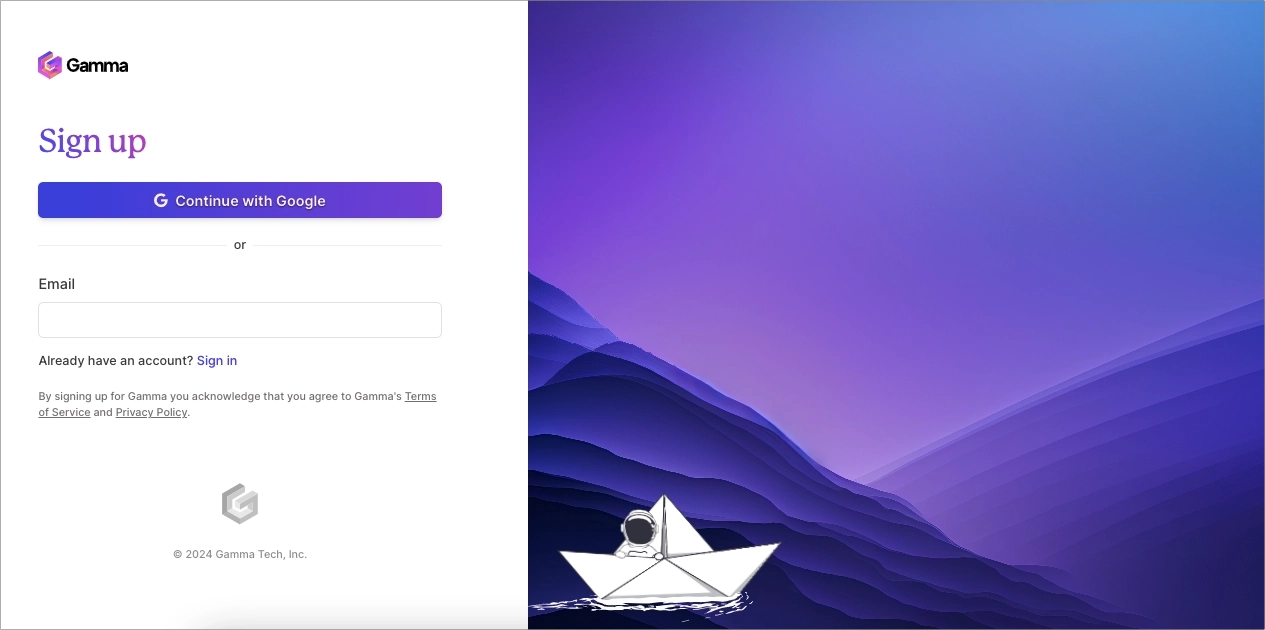
The form with a straightforward, engaging headline that includes a single form field asking only for an e-mail address is the best option for lead generation purposes. An alternative sign-up via the Google Account button is a user-friendly practice that increases conversions. The form should be visually complementary to the entire site.
3. Implementing clear pricing plans
The third good practice is to showcase all plans with their prices. This practice allows users to understand various value propositions and choose the best option for their purposes. Clear pricing is a must, but it should involve not only the price but also short descriptions indicating the target users for whom useful options have been selected.
Take a look at the example below:
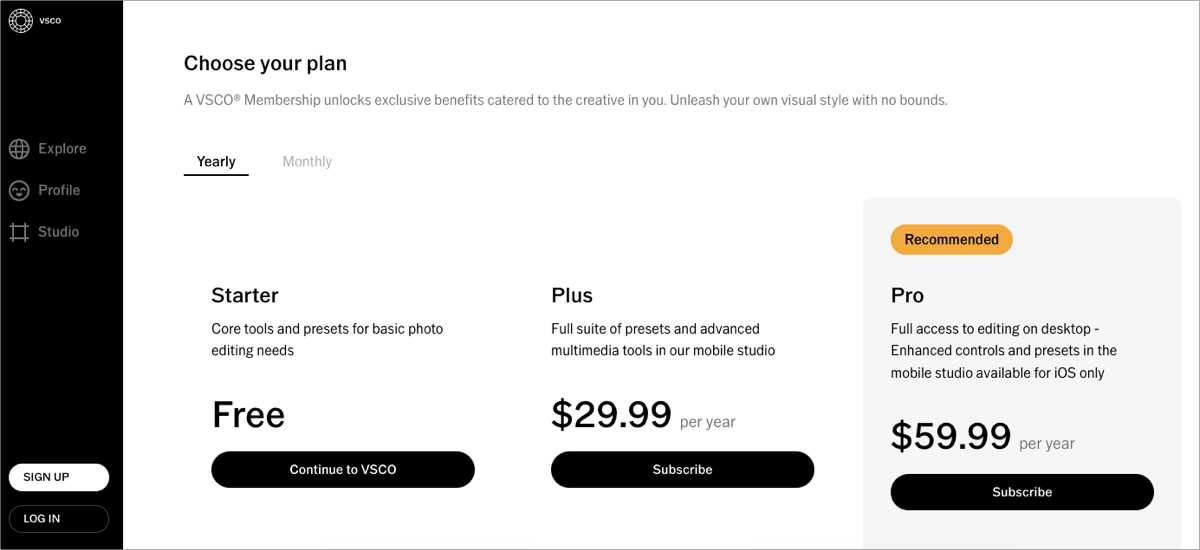
This pricing is clear, informative, and well-suited for the target audiences. Below the subscription buttons, which are outstanding and straightforward, the plan descriptions also include a full list of features available to make users sure they match the best option for their purposes.
4. Adding a coming soon section
The fourth best practice for software landing pages is to add a coming soon section. Showcasing features that your team is working on is the best option to fully use the potential of your landing page as a digital marketing tool for Software and SaaS businesses.
Take a look at the example below:

Communicating the coming soon features helps you build a loyal audience, keep interest, and allow for gathering leads – adding a newsletter subscription button in this section allows for tracking user engagement and measuring the feature’s success before its premiere.
How Can I Optimize My Software Landing Page for Higher Conversion Rates?
To optimize your software landing page for higher conversion rates, use the right tool, like Landingi, that allows you to implement the 5 following strategies:
- Mobile optimization – ensure your landing page is fully responsive and offers a seamless experience on mobile devices. With a significant number of users accessing content on mobile, this is crucial for maintaining engagement and conversion rates.
- Loading speed and performance – optimize your page’s loading speed. A fast-loading page improves user experience and reduces bounce rates, which can positively impact conversions.
- A/B testing – regularly test different elements of your landing page. This method allows you to compare various versions of a landing page to determine which performs best in terms of conversion rates. Even minor modifications in landing page elements such as headlines, copy, and CTAs can significantly influence conversion rates when tested via A/B testing. Use these insights to make data-driven improvements.
- SEO optimization – use relevant keywords to improve your landing page’s visibility in search engine results. This can help attract more targeted traffic to your page.
- Clear navigation and design – ensure your landing page is easy to navigate with a clean, intuitive design. Avoid clutter and focus on guiding users toward the desired action.
Beyond these, personalization is another potent method to enhance your software landing page. You can provide more relevant and engaging content on landing pages by targeting specific buyer personas with unique pages tailored to their interests and behaviors.
What Are the Key Elements of an Effective Software Landing Page?
An effective software landing page typically includes 6 key elements:
- Compelling headline – captures the essence of the software and its primary benefit.
- Benefit-focused content – emphasizing how the software solves problems or improves situations for the user.
- High-quality visuals (screenshots, videos, or graphics) – effectively showcasing the software’s interface and features.
- Strong CTA – encouraging users to take a specific action, like signing up or requesting a demo.
- Testimonials or reviews – serve as credible social proof to build trust.
- Clear value proposition – explaining what makes the software unique and valuable.
An effective software landing page demands a synergy of key elements that captivate visitors and steer them toward conversion.
A clear value proposition helps visitors quickly understand the unique benefit or solution the product or service provides. Engaging visuals, such as high-quality images, videos, or gifs, capture attention and serve as a source of inspiration, aiding in the conversion process.
Persuasive copy guides visitors towards the action they should complete and is customer-centric, focusing on the benefits rather than just features. A strong CTA that stands out and provides clear instructions on what the visitor should do next is crucial. Lastly, integrating trust signals, like user testimonials or trust badges, can foster credibility and trust with prospective customers.
What Is the Best Software Landing Page Builder?
The best software landing page builder is a multifunctional, extensive platform that serves not only as a great page creator but also delivers a toolkit necessary to analyze and optimize landing pages, run A/B tests, and visualize specific insights. The selection largely hinges on your specific requirements and budget. Several options in the market offer various features and pricing plans, but the best choice is Landingi for its user-friendly interface, a wide array of templates, and robust side features, all in one, suitable for both advanced and inexperienced users platform.
You don’t have to look for external tools to run A/B tests or analyze data-based insights; it’s enough to choose the right landing page builder, like the Landingi platform. With its creator, you can easily duplicate landing pages and set changes to run split tests for your software landing page.
The complimentary EventTracker tool allows tracking user behavior and measuring results – analytics have never been easier before. Gathered data are presented on your dashboard so you can optimize the landing page by choosing the most effective elements.
Over 170 integrations allow you to create a high-performing MarTech ecosystem and use the potential of landing pages as the most effective marketing tools for Software and SaaS businesses. You can succeed without time and budget-consuming solutions – Landingi, with its intuitive, user-friendly interface, allows you to build the best software landing pages that convert and manage them to continuous optimization for better results.
Conclusion
Landing pages are a powerful tool, especially for Software and SaaS businesses, designed to convert visitors into leads or customers, measure marketing strategy efficiency, and scale business. They should be created with a clear goal, to guide visitors straight to complete the desired action.
Excellent examples of software landing pages you’ve discovered should give you the essential knowledge and ideas for creating your own. Its success lies in understanding your target audience, crafting a compelling value proposition, and continuously testing and optimizing. With these strategies, you can create a software landing page that not only looks great but also delivers results.
It’s time to start crafting your software landing page. Try a powerful landing page builder – Landingi, and discover the potential of landing pages as the best marketing tool for your business.

